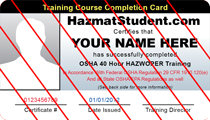| Recipe for Disaster | Emergencies in the Workplace |
Emergencies and disasters can happen anywhere and often without warning. Effective safety and health management systems in the workplace are crucial to ensure workers are prepared to handle emergency situations.
When required by OSHA standards, firms with more than 10 employees must have a written emergency plan, while smaller companies can verbally communicate their plan to employees. An emergency plan should include procedures for escape, the shut-down of critical operations, accounting of employees after an evacuation, rescue and medical duty assignments, and a plan for reporting the emergency as needed.

An Emergency Response Coordinator, as well as a backup coordinator, should be designated to determine the potential emergency situations that could occur and develop procedures for handling the situations. In the event of an emergency, the Emergency Response Coordinator should direct emergency activities and the evacuation of personnel. They should also ensure emergency services are notified and direct the shutdown of company operations as needed.
Emergency Response Teams need to be trained on various duties, such as providing first aid and using fire extinguishers. Worksites located more than 4 minutes away from a medical provider need to ensure there is at least one person trained in first aid on-site during all shifts. First aid supplies, emergency phone numbers, and pre-arranged ambulance services also need to be readily available. Emergency Response team members should also know the procedures for operation shutdown, chemical spill control, hazardous materials emergency response, and search and rescue.
Employees need to be informed of the types of emergencies that potentially could occur, including hazards from toxic chemicals, flammable materials and other special hazards that may be present in the workplace. Employee emergency training should include learning about: emergency plan, alarm systems, shutdown procedures, reporting procedures, and evacuation plans. Training on personal protective equipment and it’s availability should be included where appropriate. Employees should be trained on emergency procedures when they are hired, when job processes or equipment change, job location changes, and at least annually. Random drills should also be incorporated annually.
For additional information on preparing for workplace emergencies, visit OSHA’s Emergency Preparedness and Response page.



